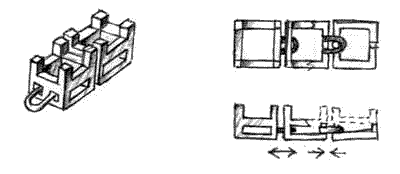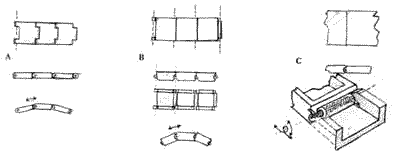|
|||||||||||||||||||||||||||
|
||||||||||||||
|
Connections with half ring for settings and griffes
This union is more bound than the preceding one (dis. 2 B) since the "U" half ring is welded on one side of the points to join,while the other curve part goes round the cutting-hinge of the other piece. The movement is given by the space of the game around the hinge, that has the function of keeping the half ring still. The more this space is reduced the more everything will appear stiff. |
 |
|||||||||||||
|
Joint connections with clasps (hinges, zips).
It consists in joining two parts that fit together in a straight way (dis. A). Its terminal part mounts a that is crossed by a hinge and binds it allowing to move in one direction. The beauty of this clasp is its meccanic precision joined to the possibility of not seeing it because it's situated underneath the external volume. In some objects like small boxes, frames, watches, bracelets that |
||||||||||||||
 |
||||||||||||||
|
often are usued open, inside the zipper is inserted, in an invisible way, the clasp that will keep the object open (dis. C).
|
||||||||||||||
|
Connetion with a hinged stud
This is usually used to join some settings. The setting has two holes that go through each the side (dis. A), and a cut in the opposite direction,where the stud will be placed (dis. B) this will be blocked by the hinge that will cross the setting and the stud (dis. C). Even if this connection gives a good movement in one direction it keeps a certain rigidity if the |
||||||||||||||
 |
||||||||||||||
|
arrangements of the studs are very precise. It may happen that the studs will bend if they are too fine (bracelets are subjected to collisions and considerable tractions)
|
||||||||||||||
|
Adorned kinetic connection
It's the union of two parts that are kept still by joining them with hinges on the opposite diameters of a spherical element (dis. A) in this way you get a horizontal and vertical movement that are the exact opposite. This connection is very functual, but not always utilizable because of its working technique. |
||||||||||||||
 |
||||||||||||||